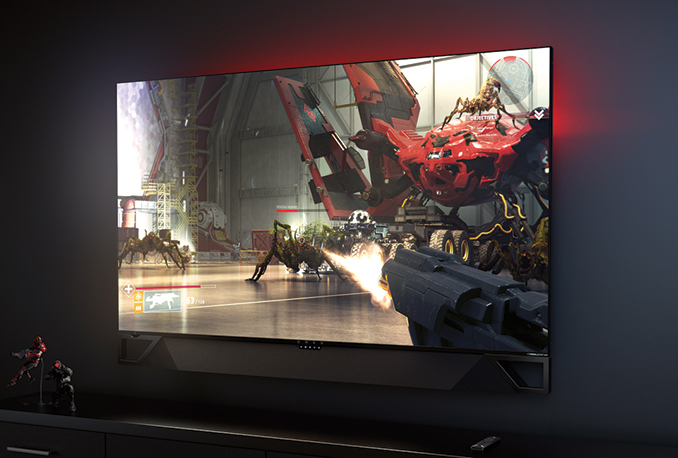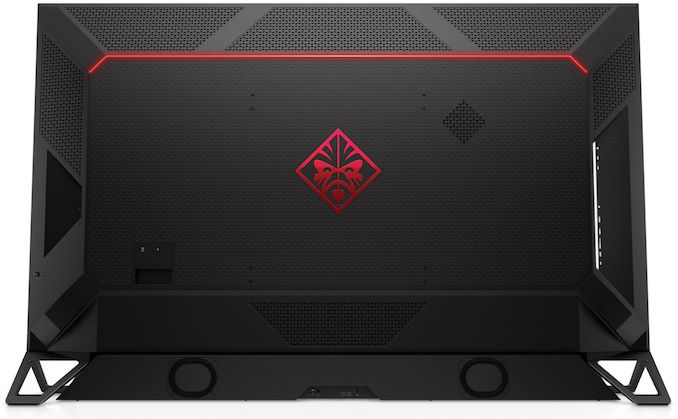NVIDIA’s 65-inch Big Format Gaming Display Is Here: HP OMEN X Emperium
by Anton Shilov on March 14, 2019 3:00 PM EST
Huge displays for entertainment and productivity are getting increasingly popular these days as prices are falling. Last year NVIDIA proposed a reference design for Big Format Gaming Displays: 65-inch monsters featuring a 120/144 Hz refresh rate along with the company’s G-Sync HDR technology. The initiative was supported by three companies: Acer, ASUS, and HP. But while all of them formally announced their BFGD products at CES 2018, only HP has started to sell one - the HP OMEN X Emperium.
Officially introduced at CES 2019, the HP OMEN X Emperium 65 display is based on a 64.5-inch 8-bit AMVA panel featuring a 3840×2160 resolution, 750-1000 nits brightness (typical/HDR), a 3200:1-4000:1 contrast ratio (minimum/typical), 178° viewing angles, a 120 - 144 Hz refresh rate (normal/overclocked), and a 4 ms GtG response time with overdrive enabled. Just like other G-Sync HDR monitors released to date, this one is equipped with a 384-zone full direct-array backlight to offer a finer-grained HDR experience, and enhanced with quantum dots to guarantee precise reproduction of 95% of the DCI-P3 color space. The ultra-large display can connect up to four devices using one DisplayPort 1.4 as well as three HDMI 2.0b ports.
To make the OMEN X Emperium 65 display more attractive both to gamers as well as those looking for other kinds of entertainment, HP outfitted its BFGD with a soundbar rated for 120 W of output power (with three stereo amps and Low Frequency Array technology) as well as a built-in SHIELD TV console that can be used as a media player to stream content from Amazon Video, Netflix, Hulu and other services.
| Specifications of the OMEN X Emperium 65 | ||
| 4JF30AA#ABA | ||
| Panel | 64.5" AMVA | |
| Native Resolution | 3840 × 2160 | |
| Maximum Refresh Rate | Normal: 120 Hz Overclocked: 144 Hz |
|
| Response Time | 4 ms with overdrive | |
| Brightness | Typical: 750 cd/m² HDR: 1000 cd/m² |
|
| Contrast | Minimum: 3200:1 Typical: 4000:1 |
|
| Viewing Angles | 178°/178° horizontal/vertical | |
| Pixel Pitch | 0.372 mm² | |
| Pixel Density | 68 ppi | |
| Backlighting | 384-zone full direct-array backlight | |
| Color Gamut Support | DCI-P3: 95% | |
| Media Playback Capabilities | Built-in NVIDIA SHIELD TV game console | |
| Inputs | 1 × DisplayPort 1.4 3 × HDMI 2.0a 1x USB-B HDCP 2.2 |
|
| USB Hub | 2-port USB 3.0 | |
| Audio | Output power: 120W Impedence: 4 Ohms Frequency range: 40 - 20k Hz Sensitivity: 91 dB @ 1K Hz at 1m full scale volume Magnet Materials: Ferrite Diaphragm: Aluminum Line out: 1 S-PDIF out: 1 HDMI ARC: 1 |
|
| Power | Idle | 0.5 W |
| Typical | ? | |
| Peak | ? | |
| Launch Price | $4,999 | |
HP recently started to offer its OMEN X Emperium 65 online at a price of $4,999.99. As of press time, HP’s store stated that only nine units of the OMEN X Emperium were left in stock, so it is possible that there isn't many in the first batch.
Related Reading:
- HP at CES 2019: OMEN X Emperium 65-Inch 144Hz G-Sync HDR Monitor with Soundbar
- IO Data Announces M4K651XDB: A 4K 64.5-Inch Display with HDR10
- NVIDIA Announces Big Format Gaming Displays: 65-inch 4K@120Hz HDR Display with G-Sync & More
- JapanNext JN-VC490UHD and JN-VC550UHD: 49-55 inch, Curved 4K, FreeSync, HDCP 2.2, Under $900
- Philips Preps 499P9H Curved 49-Inch 5K Display with USB-C Docking & Webcam
- Dell U4919DW Curved Display Unveiled: 49 Inches, 5120x1440
- Philips Unveils 43-Inch 4K Gaming LCD with DisplayHDR 1000, DCI-P3, FreeSync
Source: HP












53 Comments
View All Comments
Valantar - Thursday, March 14, 2019 - link
And another $20 000 in a couple of years when the burn-in gets bad (this is for use with a PC, after all).imaheadcase - Friday, March 15, 2019 - link
Stop spreading FUD about burn in. Its not a issue unless you want to be a idiot and run a static screen 24/7..which no one on a PC does.Valantar - Friday, March 15, 2019 - link
So you don't have a taskbar, or consistently placed UI elements in your applications? Do you reskin Windows to make window management buttons invisible? Or if all you'd use this for is games, do you not play a lot of the same game, with the same UI elements in the same spots? Yes, you would. There are methods of compensating for burn-in, but none are effective for largely static images like a PC desktop (pixel shifting won't help against your Chrome taskbar icon burning in - you'd have to move the entire icon quite a distance.It would likely take a few years, but burn-in would inevitably happen. It's unavoidable with OLED, and one of the key reasons why it's a technology poorly suited to PC use.
close - Friday, March 15, 2019 - link
Valantar, you'll use this for gaming, not for office work. It's not marketed as a daily driver. Just look at the promo pics. This is a gaming oriented TV basically.Even some games have static content that could conceivably burn in but if you spend 5K on this it's probably less of a concern that in 3-4 years it shows some signs.
Beaver M. - Friday, March 15, 2019 - link
The burn in problem doesnt go away when you turn off the screen. It adds up. The more you have the same pixels active with the same colors (or not at all - black bars on cinema movies or 4:3), the quicker they will age. You WILL have burn in at some point, there is no way around it. On a PC you will have HUDs of games and a task bar and desktop icons and an email client, and a browser, etc, which will all be the same position all the time.There is a reason why OLED hasnt established on monitors. And even on TVs its problematic if you play console or watch the same station a lot.
Deal with it, OLED isnt what we hoped for.
BenSkywalker - Saturday, March 16, 2019 - link
How long did it take before you started seeing burn in?Had some down time this past week and spent roughly twelve hours a day each day playing through Final Fantasy XII on my primary gaming display, an E6 OLED. All uniformity color tests are *far* more uniform than any LCD I've seen.
This has been my primary gaming display for three years and I see burn in like I see unicorns.
Opencg - Sunday, March 17, 2019 - link
hes talking about mura not burnin I think. slight variations only visible on fullblack sections. its usually present from day 1 on oled. I havent ever seen burnin on any display Ive ever used and I have used every type usually for 8 hours a day average over long periods.knowledgeable people say burnin may be reversed by using images that change rapidly. this may be why almost nobody sees it.
Valantar - Monday, March 18, 2019 - link
OLED burn-in is irreversible once it's actually set in, and is actually most visible on an all-white screen, as what actually happens is the subpixels wearing out unevenly and growing dimmer. The worst cases I've seen are demo smartphones and tablets (specifically Samsung, who purportedly have the best OLED tech around). Of course, these show the same demo videos for large portions of the day 6 or 7 days a week, but the videos are designed to not have any static elements, with even text mostly being in movement or on screen for just a couple of seconds at a time, and a lot of color variation. At the store I used to work at, every single Samsung AMOLED phone and tablet had very visible burn-in within a year. A PC display would likely get it even sooner, given the higher amount of static display elements, but this would of course be offset by less use per day. I still wouldn't trust it to last more than a few years.darkswordsman17 - Thursday, March 14, 2019 - link
There's no reason it should cost anywhere close to that. Heck, there's no reason it shouldn't be able to cost less than this.There's no reason why TV manufacturers couldn't offer something that is 90% of what this is (MVA panel, doing 120Hz, VRR especially since HDMI 2.1 will bring it as part of the spec, HDR) for 1/3 the price. If I'm AMD I'd be trying to help companies do just that and undercut this thing massively. Try to get brands to offer whole group of models (get them to offer 32-65" models; the 32" ones would be especially popular with PC gamers I think) with these features/capabilities. Get Microsoft and Sony to work deals to bundle or possibly integrate their consoles with them.
Products like these shouldn't cost any more than normal ones either since they could ditch the smart functions knowing that people are buying them to let their PC/video card and even console handle those. This way, it gets out of the way, they could even ditch their processing controls since again the intended market is going to use other devices for that anyway. Maybe have some simple scaling features (so for instance, it could take 1080/720 signals up to native resolution since they'd scale easily to native resolution and with 120Hz refresh you could scale 24/30/60 content.
darkswordsman17 - Thursday, March 14, 2019 - link
Oh, and this would also be a great market for Samsung to target with their microLED displays (the ones where they're made of multiple individual panels, so for 65" 4K, you'd have 4 ~32" 1080p panels, so if you have several friends over you could split it and each person gets their own display). I know MicroLED is expensive right now, but I'd think they could probably be more competitive with these BFG Displays, and they should easily trounce them in performance and even features (these don't even have HDMI 2.1?!? Which they try and make up for it with the DisplayPort, but that's only useful for PC; plus while the Shield is solid, it could use an update).An updated model, that gets the price much more reasonable, includes HDMI 2.1, and maybe if they can talk Nintendo into using a new Tegra chip that pairs current ARM CPUs and current Nvidia GPU on 7nm, an integrated Switch Dock with also wireless display capability so that the Switch could work like the Wii U tablet pad. This updated Switch when docked would charge but would also take over the duties that the Shield is doing on these first versions. They could also include motion tracking and IR cameras so you could do those things. Maybe offer an updated Wii Sports like suite.